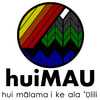|
Piʻi i uka.Continue the ascent to the Wao Lāʻau.
|
Wao MaʻukeleContinuing our ascent along the ala ʻūlili, we enter the wao maʻukele. This region is part of the wao akua, and is characterized by its dense rain forests, dominated primarily by large ʻōhiʻa lehua, koa, olopua, kōpiko, kōlea, and hāpuʻu. Here, "poʻe kāwili manu," bird catchers, came to catch such valued birds as the ʻiʻiwi, ʻōʻō, and mamo whose feathers were gathered and utilized in making ʻahuʻula and mahiole for the aliʻi.
For over a century, the wao maʻukele regions of Kūkaʻiau, Koholālele, and Kaʻohe were utilized for cattle ranching and sugar planting. These land use practices have been the causes of much deforestation in the wao maʻukele, leaving small kīpuka of rain forest scattered along gulches and steep ridges, where cattle, and tractors couldn't get to them. |
|
Hoʻi i ke ala ʻūlili.Return to the Ala ʻŪlili.
|
Iho i kai.Descend to the Kula.
|
